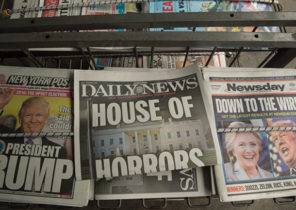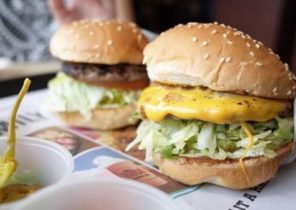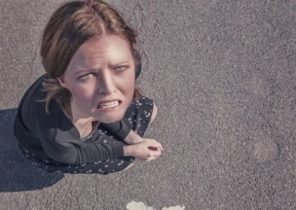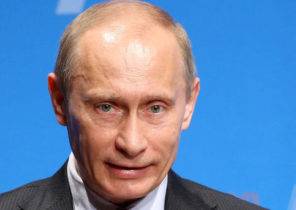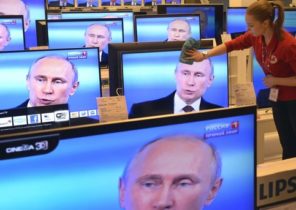Near Moscow had just ended the construction of the Main temple of the Russian Armed forces, praising its army and military. In the notes it says that it is erected “in memory of the feats of the Russian people and their armies in all wars”.
Recently, however, against the construction of this sanctuary in the Russian media space is quite an active discussion and even a critical assessment was given to create in the Church a mosaic with the images of President Putin, a former Soviet dictator Stalin and slogans, essentially glorifying carried out by Russia in 2014, the annexation of the Crimean Peninsula. This temple symbolizes the strengthening of Patriotic propaganda and the militarization of Russia, carried out by Putin’s government.
First plans for the construction of the Main temple of the Russian armed forces announced in September 2018 the country’s defense Minister Sergei Shoigu. As the site of its construction, was elected near Moscow in the town of Kubinka Park “Patriot”, on the site which during the Second world war began and has received a powerful development of the famous counter-offensive of the Soviet red army near Moscow. During the same month, the official ceremony of laying the first stone in the Foundation of the temple was attended by Vladimir Putin. The construction of the temple was scheduled to be completed for the celebrations dedicated to the 75th anniversary of the victory over Germany (may 9).
Looks like a rushed up ballistic missiles, this temple has a height of 95 meters and is the third largest after the Cathedral of Christ the Savior (Moscow, 103 meters) and St. Isaac’s Cathedral (Saint Petersburg, 101 meters). Distinctive features of the main naval Church of Russia (it is also called “in honor of the resurrection of Christ”) is a protective color of its façade, resembling the color of military uniforms, as well as the pointed elements of its design, resembling the contours of modern warships. The diameter of the drum of the main dome is 19,45 meters, symbolizing the date of the historic victory — 1945. The height of the belfry is 75 meters, cross-referencing, therefore, with the anniversary date of the completion of the temple — the 75th anniversary of Victory, celebrated in 2020.
Announcing the plans for the construction of the temple, defense Minister Shoigu stressed that “it will be a spiritual, educational and educational center for soldiers, Orthodox priests and Russian citizens and are truly folk.”
On the official website of the Main military Church emphasizes that “the temple in honor of the Resurrection, dedicated to the 75th anniversary of the Victory in the great Patriotic war and the heroic deeds of the Russian people in all the wars that have befallen our country”, is created not just for the military.
The construction of a Church is widely involved in public donations. It is known that to date they collected about 3 billion rubles. However, this amount is to cover planned expenditure is not enough, therefore the remaining funds will be attracted from the budgets of the city of Moscow and Moscow region, as well as private sources.
However, in mid-April, many Russian media reported that the Church was not only the canonical image of Christ the Saviour and other saints, but also the mosaic image of Putin and other senior Russian officials. Among them: defense Minister Sergei Shoigu, foreign Minister Lavrov, the Secretary of Security Council Patrushev, FSB Director Bortnikov, chief of the General staff Gerasimov, etc.
In the mosaic he is depicted in a crowd scene, in which there is killing hundreds of thousands of political opponents and ordinary people fearful of the Soviet dictator Stalin, or in which people carry banners “Crimea is ours!”. As for Stalin, Russia has a deeply rooted his score as a “hero, led the people to victory in world war II and expanded Soviet territory”.
April 27, the Russian newspaper economic profile “Vedomosti” wrote: “This temple is difficult to name in the true sense of God’s temple in which people communicate with God. Rather, it is a monument aggrandizing territorial seizures and the current regime.” As for the mosaic with Stalin, the newspaper about this irony: “It is perhaps the first case in the history of Russian Orthodoxy, when the Church praises the Orthodox persecutor and murderer”. “Vedomosti” made for that “huge sums spent on the construction of the temple, better would be aimed at supporting the military retirees and veterans.”
Fearing criticism due to a mosaic picture of the Board of Trustees of the Church, responsible in particular, for his artwork, decided this image to remove. However, the slogan for the accession of Crimea to Russia remained.
In Russia at the present time a continuing decline in the level of support of President Putin, against the backdrop of the ongoing economic downturn and deterioration of living conditions of the population, a “cooling off” of enthusiasm in connection with the annexation of the Crimea and fatigue from prolonged stay in power of today’s top leadership of the country.
In these circumstances, Putin has by all means to revive in the country the centripetal tendencies and Patriotic sentiments. In order to strengthen the self-identity of Russians, he is actively trying to use such slogans as “Russia is a great military power” or “Russia is a country winner in the Second world war” (SIC — approx. ed.).
Indeed, at every opportunity, Putin boasts new samples of Russian weapons and military equipment. Japanese-Russian peace Treaty negotiations it requires Japan to “acknowledge the fact of the loss of Japan in world war II, sovereignty over the “Northern Islands””. He vehemently condemns adopted last year by the European Parliament’s resolution that “Nazi Germany and the Soviet Union, as two of the totalitarian state, equally responsible for the outbreak of the Second world war”, calling it “complete nonsense”.
Under these conditions, the Main temple of the Russian Armed forces symbolizes the course of the current Russian government to gain control over the people due to the militaristic and Patriotic propaganda. Not having a prospective vision of the ways of lifting the living standards of the population, today the Russian leadership relies on the exaltation of the military power and past military victories. This is a reflection of the difficult situation faced by the regime.
